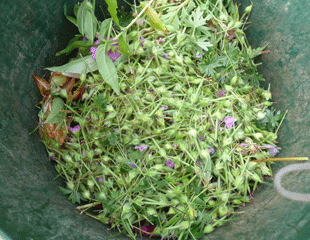Why dead heading is important
Posted on
 |
Dead heading is important to get the maximum number of flowers and flowering time from a plant. Why? The purpose of most plants, perennials and annuals, is to reproduce. Plants reproduce by producing flowers which become seeds which are shed and dispersed at which point the cycle is complete. To encourage a plant to keep flowering, or to produce a second flush of flowers, remove the spent flower so no seed is produced and the plant will strive to produce another flower. |
|
Plants varying in how sensitive they are to dead heading, in terms of producing more flowers. Some plants, such as Clematis Crystal fountain, if deadheaded, may produce a second flush of flowers. For other plants, such as Sweet Peas, hardy Geraniums, and Roses, dead heading is vital to keep the plant flowering all summer long. Having explained this to a friend recently, she replied, "I did wonder why my sweet peas stopped flowering!" Head heading is also very important for bedding plants to keep them flowering. If they are not deadheaded, the flowers will become less and less, and the plant leggy and will soon go over. With a little care most bedding plants should flower for weeks if not months. Plant such as hardy geraniums, common name, Cranesbill, can be very time consuming to dead head. The image is of the dead flower heads removed from a hardy Geranium in one session. If it become too much, an alternative with Cranesbill, Achillea mollis is to sheer the plant close to ground level and if done early enough in the growing season, it may produce a second flush of flowers. Doing this will certainly produce fresh green foliage if the plant is looking tired. If you don't like the look of plants cut back you can always sheer them before a holiday and they will have produced new growth by the time you are back. Late June and July is a suitable time to cut back hardy geraniums. If you are looking to dead head flowers with a single flower spike such as Delphinium, Digitalis (Foxglove) Salvia, just remove the spent spike and sometimes the plant will reward with a smaller second flush alongside. |
|

Add a comment: